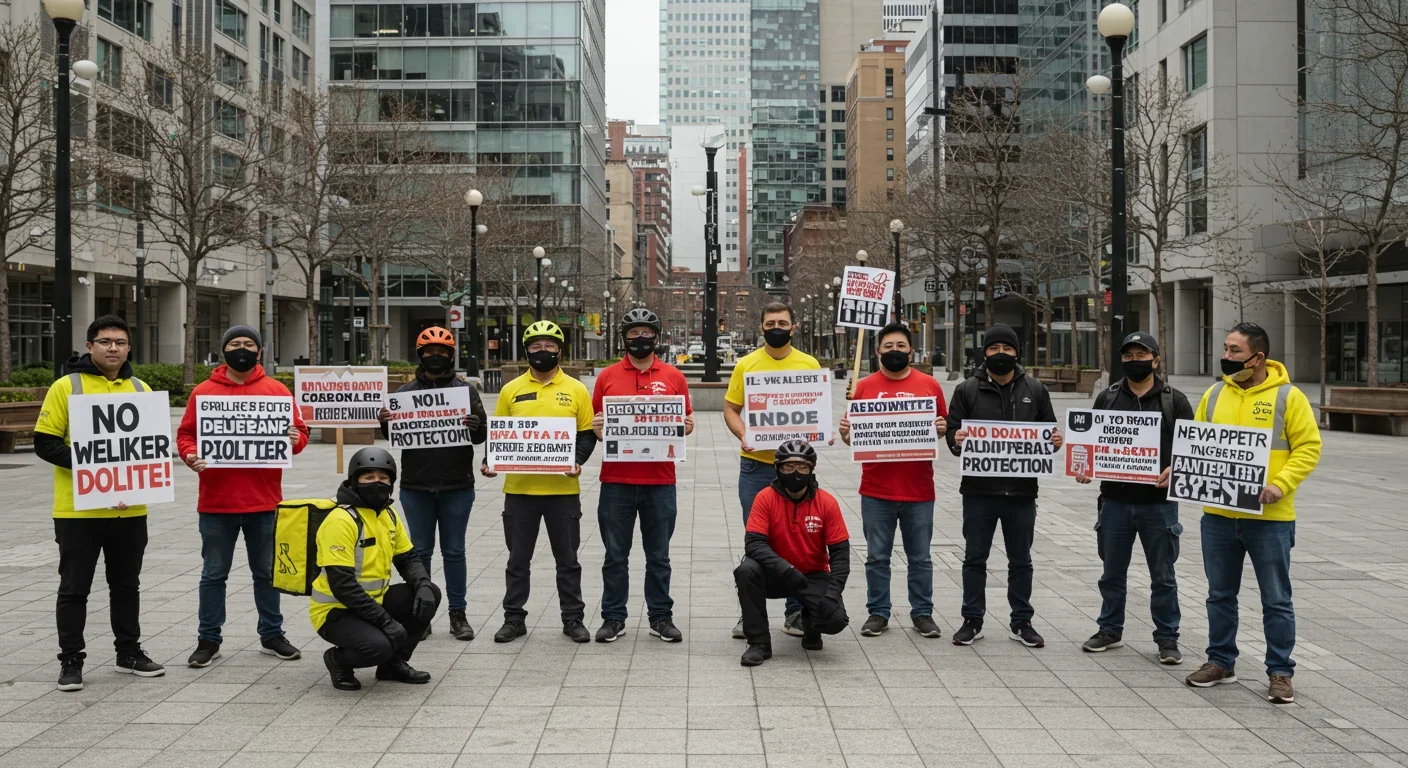When Reality Becomes Partisan: The Death of Shared Truth

TL;DR: The gig economy, now valued at $582 billion globally, promises flexibility but delivers income volatility, retirement gaps, and legal ambiguity for most workers. While 5.6 million high-earning U.S. independents thrive, 73% of rideshare drivers lose money, and only 18% of UK self-employed workers save for retirement. Governments worldwide are responding with hybrid regulations—from California's Prop 22 to Malaysia's Gig Workers Bill—but the future hinges on whether we build portable benefits, empower collective bargaining, and hold platforms accountable. The gig economy is both freedom and trap; which it becomes depends on choices we make now.

By 2030, the global gig economy will employ over half a billion workers—yet most will enter retirement with less savings than a traditional employee accumulates in five years. This isn't a failure of individual discipline. It's a systemic design flaw baked into the platforms we celebrate for "liberating" work. The gig economy promises autonomy, flexibility, and entrepreneurial freedom. But scratch the surface, and you'll find income volatility masked by instant payouts, health risks subsidized by workers themselves, and a regulatory patchwork that leaves millions in legal limbo. What begins as a side hustle to pay off student loans can become a trap where 73% of participants unknowingly lose money. This article dissects the gig economy's dual nature—exploring how it reshapes labor, who profits, who pays, and what the next decade holds for the 72.9 million Americans already living gig to gig.
The gig economy didn't emerge from a technological breakthrough—it was born from economic necessity and platform innovation. Between 2016 and 2023, online gig postings surged 41%, driven by corporate layoffs, the 2008 recession's long shadow, and the COVID-19 pandemic's acceleration of remote work. Platforms like Uber, Upwork, and DoorDash transformed smartphones into job boards, payment processors, and performance trackers, fragmenting traditional employment into task-based micro-contracts.
Globally, the market has exploded. In 2025, the gig economy is valued at $582.2 billion and is projected to hit $2.18 trillion by 2034—a compound annual growth rate of 15.79%. The Middle East alone contributes over 7% of the global market, with Saudi Arabia registering 2.25 million freelancers who generated $19 billion in 2023, representing 2% of the kingdom's GDP. Egypt's freelance earnings rose 22% year-over-year, making it one of the world's five fastest-growing gig markets.
Yet this growth masks a disturbing reality: the gig economy operates on a business model that externalizes costs onto workers. Drivers pay for fuel, maintenance, insurance, and vehicle depreciation. Freelancers fund their own health coverage, retirement accounts, and unemployment safety nets. Platforms pocket the efficiency gains while shedding the responsibilities that defined the 20th-century employment contract. This isn't liberation—it's risk transfer at scale.
The gig economy isn't unprecedented. It echoes the piece-rate labor of the Industrial Revolution, when workers were paid per garment sewn or widget assembled, with no guarantee of steady hours or income. Back then, reformers fought for the eight-hour workday, workplace safety laws, and collective bargaining rights. Those victories created the employment framework we're now dismantling.
In the 1930s, the New Deal established Social Security, unemployment insurance, and employer-provided benefits as buffers against economic shocks. The assumption was simple: most people would work for one or two employers over a career, accruing seniority, pensions, and predictable income. That model held for decades. But globalization, automation, and financialization eroded it. By the 2000s, companies had mastered the art of "flexible staffing"—using temps, contractors, and outsourced labor to cut costs. The 2008 crash accelerated the trend. Suddenly, millions of displaced workers turned to TaskRabbit, Etsy, and Mechanical Turk—not as side gigs, but as primary income.
History teaches us that technological shifts often precede social upheaval. The printing press empowered mass literacy but also sparked religious wars. The steam engine drove industrialization and child labor. The gig economy, similarly, offers genuine benefits—autonomy for parents, supplemental income for retirees, global opportunities for skilled freelancers—but it also resurrects the precarity our grandparents fought to escape. The difference? This time, the exploitation is algorithmic, opaque, and wrapped in the language of empowerment.
At its core, the gig economy is a digital marketplace connecting businesses with freelancers for short-term, task-based work. Platforms handle job matching, payment processing, dispute resolution, and—crucially—worker classification. By labeling workers as "independent contractors," companies avoid minimum wage laws, overtime pay, health insurance, workers' compensation, and unemployment contributions. This classification isn't accidental. It's the foundation of their profitability.
Consider Uber's pay structure. Drivers receive roughly 36 cents per engaged mile under California's Proposition 22—less than half the IRS standard mileage rate of 70 cents, which accounts for fuel, maintenance, insurance, depreciation, and overhead. That 34-cent gap isn't a rounding error; it's a feature. Uber benefits from a constant influx of new, part-time drivers who treat the work as temporary and don't demand career-level compensation. Studies show 50–70% of new rideshare drivers quit within their first year, often after realizing they're subsidizing rides with their own vehicle equity.
The platforms' genius lies in psychological design. Instant payouts create the perception of liquidity, masking underlying losses. Gamified ratings and surge pricing generate urgency and competition. Algorithmic dispatch obscures how much drivers earn per hour when idle time, repositioning, and vehicle costs are factored in. A MIT study estimated the median Uber driver nets just $3.37 per hour after expenses—a figure platforms fiercely disputed but never fully refuted.
This model extends beyond rideshare. Delivery apps, freelance marketplaces, and staffing platforms all externalize risk. Businesses love it: on-demand labor without long-term obligations. But for workers, the tradeoff is brutal. Flexibility comes at the cost of stability, benefits, and—often—dignity.

The gig economy isn't just reshaping work—it's redefining entire industries, urban planning, and social safety nets. Food delivery has exploded, with platforms like DoorDash and Grubhub expanding into groceries and pharmaceuticals. Hotels now compete with Airbnb hosts. Taxi companies have been decimated. Even white-collar professions—legal research, graphic design, software development—are being unbundled into project-based contracts.
This shift affects cities. Gig workers flood streets, increasing traffic and pollution. Affordable housing becomes scarcer as landlords list units on short-term rental platforms. Municipal budgets strain as fewer workers qualify for employer-sponsored health plans, pushing them onto Medicaid or emergency rooms.
Culturally, the gig economy feeds "hustle culture"—the glorification of nonstop productivity. Social media amplifies this, with influencers showcasing side gigs, passive income, and financial independence. Yet 77% of millennials report burnout, and 62% of working mothers experience it. The promise of autonomy curdles into always-on availability. Gig workers check apps compulsively, fearing they'll miss a lucrative surge or lose their rating if they decline requests. Boundaries dissolve. Work invades evenings, weekends, and vacations.
The labor market is stratifying. A small elite—5.6 million U.S. independents earning over $100,000—thrives, leveraging specialized skills and global demand. But the majority lacks health insurance, retirement savings, and emergency funds. In the UK, only 18% of self-employed workers save for retirement, compared to 90% of employees. The current pension system, designed for long, uninterrupted careers, systematically disadvantages gig workers. As Alexandra Miles of the Institute and Faculty of Actuaries notes, "The current pensions system was a fantastic invention of a different era. Increasing numbers of modern working lives are fragmented, diverse, and uncertain."
This inequality is self-reinforcing. High earners invest in skills, networks, and tools that command premium rates. Low earners cycle through low-skill gigs, unable to save or upskill. The gig economy, rather than democratizing opportunity, risks entrenching a two-tier workforce.
Despite its flaws, the gig economy solves real problems. For parents, students, and retirees, it offers income on their terms. A single mother can drive for Lyft while her kids are at school. A retiree can tutor online to supplement Social Security. A laid-off journalist can freelance while job hunting. This flexibility is invaluable in a world where childcare is expensive, education is lengthy, and careers are nonlinear.
Globally, the gig economy opens doors. A developer in Lagos can bid on projects from Silicon Valley. A designer in Cairo can serve clients in Dubai. Platforms reduce geographic and credential barriers, rewarding skill over pedigree. In 2024, U.S. freelancers in skilled roles earned an estimated $1.5 trillion—a testament to the value they create.
For businesses, the benefits are clear. Gig platforms provide instant access to talent without recruitment overhead. A startup can hire a marketer for a three-month campaign, a hotel can staff a conference without permanent hires, and a retailer can surge warehouse workers for the holidays. This agility drives innovation and efficiency.
Some workers genuinely prefer gig arrangements. They value autonomy over security, variety over routine. They're willing to trade benefits for control. And in high-skill sectors—consulting, software, creative services—gig work can be lucrative and fulfilling.
But these success stories are the exception, not the rule. Most gig workers aren't digital nomads sipping lattes in Bali. They're delivery drivers in Houston, rideshare drivers in Mumbai, and TaskRabbit laborers in London—people hustling to make rent, not building empires.
The gig economy's hidden costs are staggering. Start with income volatility. Gig workers face unpredictable earnings, surges that vanish overnight, and algorithmic changes that slash pay without warning. A study found 57% of all workers live paycheck to paycheck—a figure likely higher among gig participants. Without steady income, budgeting becomes guesswork. Saving for emergencies, retirement, or education feels impossible.
Health is another casualty. One in three gig workers reports fearing theft or physical assault. Delivery drivers navigate traffic, aggressive dogs, and unsafe neighborhoods. Rideshare drivers endure long hours, irregular sleep, and stress-related conditions. Yet most lack employer-provided health insurance. In the U.S., they must purchase individual plans—often with high deductibles and narrow networks. In the UK, gig workers rely on the NHS for basic care but may need private insurance for timely specialist treatment. Across the Middle East, freelancers lack unemployment insurance, workers' compensation, and retirement benefits, leaving them vulnerable to catastrophic risks.
Retirement is a looming crisis. The UK's Institute of Actuaries warns that the pension system, built for stable careers, fails fragmented workers. Self-employed individuals must proactively contribute to individual retirement accounts, but only 18% do so. In the U.S., gig workers can fund IRAs or Solo 401(k)s, but volatile income makes consistent contributions difficult. The result? A generation approaching old age with inadequate savings.
Legal protections are patchy. In many jurisdictions, gig workers classified as independent contractors have no wrongful termination rights, no minimum wage, no overtime, and no collective bargaining. They can be deactivated—essentially fired—without cause or appeal. Platforms control ratings, algorithms, and pay structures, yet bear no employer responsibilities. This power imbalance is profound.
Financial traps abound. Uber settled with the FTC for $20 million in 2017 over auto loans with questionable credit terms extended to drivers. Fintech "buy now, pay later" schemes, often marketed to gig workers, carry opaque fees and high interest rates, luring users into debt spirals. Predatory lending thrives where income is unstable and traditional credit is scarce.
The gig economy's growth has sparked diverse regulatory responses. In California, Assembly Bill 5 (AB5), passed in 2020, reclassified many gig workers as employees, entitling them to minimum wage, overtime, and benefits. But platforms spent over $200 million on Proposition 22, a ballot initiative that exempted rideshare and delivery drivers from AB5, offering limited benefits instead. The measure passed, and its constitutionality remains contested.
In Europe, Spain enacted the "Rider Law" in 2021, presuming food delivery riders are employees unless proven otherwise. The EU Platform Work Directive, adopted in 2024, aims to improve working conditions and clarify employment status across member states. The UK Supreme Court ruled in 2021 that Uber drivers are "workers," not self-employed, granting them minimum wage and holiday pay—but not full employee rights like wrongful termination protections.
Asia is experimenting with hybrid models. Singapore's Platform Workers Act, effective January 1, 2025, mandates gig workers and platforms split social security contributions equally, while expanding workers' compensation and medical insurance. Malaysia's Gig Workers Bill 2025, passed in September, protects over 1.2 million workers with service contracts detailing remuneration and rights, councils for dispute resolution, and social security provisions. These laws followed major strikes—the 2022 Klang Valley food delivery strike and the 2024 "Grab Blackout" protest—showing how collective action can force legislative change.
The Middle East presents a different dynamic. Saudi Arabia and the UAE embed gig work into national visions—Vision 2030 and Centennial 2071—offering freelance visas and innovation hubs to attract talent. Yet comprehensive social protections lag. Egypt's "Freelancing and Remote Work Initiative" trains workers but doesn't extend unemployment or retirement benefits. Informality remains high—64% of the workforce in 2019—exposing freelancers to income volatility and job insecurity.
These varied approaches reflect different priorities: California balances worker rights with platform lobbying; Europe emphasizes social protections; Asia seeks middle-ground hybrids; the Middle East prioritizes growth over safety nets. No single model has emerged as best practice, but the trend is clear—governments are waking up to the gig economy's costs and intervening.

If the gig economy is here to stay, workers, policymakers, and platforms must adapt. For gig workers, financial literacy is critical. Track all expenses—mileage, fees, insurance, depreciation—to understand true earnings. Set aside taxes quarterly. Build an emergency fund covering three to six months of expenses. Contribute to retirement accounts even if amounts are small; consistency compounds. Consider income protection insurance to cover illness or injury.
Diversify income streams. Don't rely on one platform or client. Develop skills that command premium rates—coding, design, writing, consulting. Invest in education, certifications, and networking. Join gig worker associations for collective bargaining and mutual support.
For policymakers, the challenge is balancing innovation with protection. Portable benefits—health insurance, retirement, unemployment—that follow workers across jobs could address gig precarity without stifling platforms. Digital registries could track contributions and streamline access. Hybrid classifications, like Malaysia's, offer middle paths between employee and contractor. Minimum earnings floors, transparency in algorithmic pay, and wrongful termination protections could level power imbalances.
For platforms, embedded finance—instant payouts, earned wage access, savings tools—can boost loyalty and reduce churn. But genuine reform requires rethinking the contractor model. Platforms that invest in worker well-being, fair pay, and career development will attract and retain top talent. Those that don't will face attrition, regulation, and reputational damage.
HR leaders must integrate gig talent strategically, establishing governance and compliance frameworks to mitigate misclassification risk. The recent $24.75 million settlement in Lawson v. Grubhub underscores the financial stakes. Treat gig workers as partners, not disposable labor.
The gig economy's next decade will be shaped by three forces: regulation, unionization, and technology. Regulatory pressure is mounting. The ILO, OECD, and national governments are tightening rules, creating compliance headaches for platforms but offering workers new protections. Expect more AB5-style legislation, platform work directives, and hybrid models. Platforms will lobby hard—Proposition 22's $200 million campaign is a preview—but public sentiment is shifting.
Unionization is gaining traction. Traditional unions struggle to organize independent contractors, but new models are emerging. Worker cooperatives, like platform co-ops, give gig workers ownership and governance. Digital organizing tools enable rapid mobilization, as seen in Malaysia and the UK. If gig workers can overcome atomization and build collective power, they'll reshape the industry.
Technology cuts both ways. AI and automation threaten to displace gig workers—self-driving cars could eliminate rideshare drivers, automated delivery robots could replace couriers. But AI also enables new gig opportunities: data labeling, content moderation, prompt engineering. The question is whether these roles offer better pay and conditions, or simply replicate precarity in new forms.
Platform algorithms will grow more sophisticated, optimizing for profit while managing worker supply. Expect dynamic pricing, predictive scheduling, and behavioral nudges to intensify. Workers who understand these systems will fare better; those who don't will be exploited.
Finally, the gig economy's cultural narrative is shifting. The "side hustle" has lost its sheen. Burnout, inequality, and exploitation dominate headlines. Younger workers, having watched parents and peers grind for meager returns, are demanding better. The Great Resignation and "quiet quitting" signal a broader reckoning with work. The gig economy, once celebrated as freedom, is increasingly seen as a trap—unless it evolves.
The gig economy is neither savior nor villain. It's a mirror, reflecting our society's values: efficiency over security, flexibility over stability, individual autonomy over collective solidarity. For some, it unlocks opportunity. For many, it deepens precarity. The difference hinges on skill, circumstance, and power.
The promise of the gig economy—work on your terms, income when you need it, global reach from your laptop—is real. But so are the costs: income volatility, health risks, retirement gaps, legal ambiguity, and algorithmic control. The question isn't whether the gig economy will grow—it will, reaching $2.18 trillion by 2034. The question is whether that growth will lift workers or exploit them.
The answer depends on choices we make now. Will we regulate platforms to ensure fair pay and protections? Will we build portable benefits systems that support fragmented careers? Will we empower workers to organize and bargain collectively? Or will we let the gig economy entrench a two-tier labor market—a privileged few thriving while the majority hustles for scraps?
History offers guidance. Every technological revolution creates winners and losers. The printing press empowered mass literacy but also sparked wars. Industrialization built prosperity but demanded child labor laws and unions to tame it. The gig economy is no different. Its potential for good is immense—if we have the courage to shape it.
For the 72.9 million Americans, 2.25 million Saudis, and hundreds of millions worldwide already in the gig economy, the stakes couldn't be higher. This isn't abstract policy—it's their livelihoods, health, and futures. The gig economy can be a ladder to freedom or a trapdoor to precarity. Which it becomes is up to us.

Curiosity rover detects mysterious methane spikes on Mars that vanish within hours, defying atmospheric models. Scientists debate whether the source is hidden microbial life or geological processes, while new research reveals UV-activated dust rapidly destroys the gas.

CMA is a selective cellular cleanup system that targets damaged proteins for degradation. As we age, CMA declines—leading to toxic protein accumulation and neurodegeneration. Scientists are developing therapies to restore CMA function and potentially prevent brain diseases.

Intercropping boosts farm yields by 20-50% by growing multiple crops together, using complementary resource use, nitrogen fixation, and pest suppression to build resilience against climate shocks while reducing costs.

Cryptomnesia—unconsciously reproducing ideas you've encountered before while believing them to be original—affects everyone from songwriters to academics. This article explores the neuroscience behind why our brains fail to flag recycled ideas and provides evidence-based strategies to protect your creative integrity.

Cuttlefish pass the marshmallow test by waiting up to 130 seconds for preferred food, demonstrating time perception and self-control with a radically different brain structure. This challenges assumptions about intelligence requiring vertebrate-type brains and suggests consciousness may be more widespread than previously thought.

Epistemic closure has fractured shared reality: algorithmic echo chambers and motivated reasoning trap us in separate information ecosystems where we can't agree on basic facts. This threatens democracy, public health coordination, and collective action on civilizational challenges. Solutions require platform accountability, media literacy, identity-bridging interventions, and cultural commitment to truth over tribalism.

Transformer architectures with self-attention mechanisms have completely replaced static word vectors like Word2Vec in NLP by generating contextual embeddings that adapt to word meaning based on surrounding context, enabling dramatic performance improvements across all language understanding tasks.